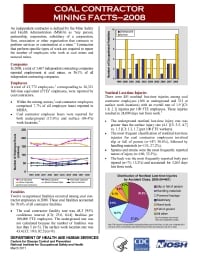Mining Publication: Coal Contractor Mining Facts - 2008
Original creation date: March 2011
Authors: National Institute for Occupational Safety and Health
NIOSHTIC2 Number: 20039164
Pittsburgh, PA: U. S. Department of Health and Human Services, Public Health Service, Centers for Disease Control and Prevention, National Institute for Occupational Safety and Health, DHHS (NIOSH) Publication No. 2011-168, 2011 Mar; :1-2
An independent contractor is defined by the Mine Safety and Health Administration (MSHA) as "any person, partnership, corporation, subsidiary of a corporation, firm, association or other organization that contracts to perform services or construction at a mine." Contractors that perform specific types of work are required to report the number of employees who work at coal mines and noncoal mines. Companies: In 2008, a total of 3,467 independent contracting companies reported employment at coal mines, or 36.1 % of all independent contracting companies. Employees: A total of 43,772 employees, corresponding to 26,321 full-time equivalent (FTE) employees, were reported by coal contractors. 1. Within the mining sectors,' coal contractor employees comprised 7.7% of all employee hours reported to MSHA. 2. Coal contractor employee hours were reported for both underground (15.6%) and surface (84.4%) work locations. Fatalities: Twelve occupational fatalities occurred among coal contractor employees in 2008. These coal fatalities accounted for 70.6% of all contractor fatalities. 1. The coal contractor fatality rate was 48 .3 [95% confidence interval (CI): 25.0, 84.4] fatalities per 100,000 FTE employees. The underground rate was not calculated because the number of fatalities was less than 5 (n=3). The surface work location rate was 43.4 [CI: 19.9, 82.5] (n=9). Nonfatal Lost-time Injuries: There were 481 nonfatal lost-time injuries among coal contractor employees (168 at underground and 313 at surface work locations) with an overall rate of 1.9 [CI: 1.8, 2.1] injuries per 100 HE employees. These injuries resulted in 24,099 days lost from work. 1. The underground nonfatal lost-time injury rate was greater than the surface injury rate (4.1 [CI: 3.5, 4.7] vs. 1.5 [CI: 1.3, 1.7] per 100 HE workers). 2. The most frequent classification of nonfatal lost-time injuries for coal contractor employees involved slip or fan of person (n=147; 30.6%), followed by handling materials (n= 131 ; 27.2%). 3. Sprains and strains were the most frequently reported nature of injury (n=160; 33.3%). 4. The back was the most frequently reported body part injured (n=73; 15.2%) and accounted for 3,265 days lost from work.

NIOSHTIC2 Number: 20039164
Pittsburgh, PA: U. S. Department of Health and Human Services, Public Health Service, Centers for Disease Control and Prevention, National Institute for Occupational Safety and Health, DHHS (NIOSH) Publication No. 2011-168, 2011 Mar; :1-2
- Coal and metal/nonmetal mining facts - 2008
- Coal and Metal/Nonmetal Mining Facts - 2008 (HTML)
- Coal Contractor Mining Facts - 2001
- Coal Contractor Mining Facts - 2002
- Coal Contractor Mining Facts - 2003
- Coal Contractor Mining Facts - 2004
- Coal Contractor Mining Facts - 2005
- Coal Contractor Mining Facts - 2006
- Mining Fact Sheets
- Rib Falls: A Major Ground Control Issue